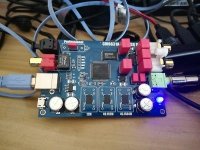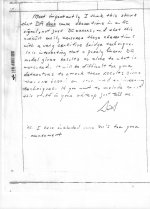Scott,
Back when I was testing resistors some of them had second order distortion, why?
There was a nice research paper using the CLT-1 that had some speculations including even IM of fundamental and thirds. The best bet is the uneven heating or mismatch of the thermocouple junction formed by the terminations. I studied this extensively for instrument applications and even made a die change to fix one. It turns out pure metals are not that different, aluminum wire to kovar was pretty small but still enough to cause a 3uV offset (which shows up as a warm up drift) between input pins on a 14pin DIP. We also published it in one of our appnotes, mounting resistors vertically to pack them into modules usually guarantees uneven heat flow and compromised some early modular products. Of course the trick of using the bottom of a Styrofoam cup to reduce air current caused 1/f noise due to thermocouple effects has been around for decades.
Many of these problems are power related so they scale as the square of the voltage and have non-electrical time constants. A complete study might include magnitude and phase of distortion vs frequency and level and an accounting of the effects of the fixturing.
Surrealistic: an audio forum where we are not supposed to talk anymore about the quality of the sound's reproduction !
Who said anything like that. There are many subgroups on this forum that talk mainly amongst themselves, if you haven't noticed some of them don't subscribe to the same sound quality/accuracy creed as here. They include folks attempting to get the most out of higher end mobil devices.
More debating points, Scott? Cell phone audio? really?
Really.
-RM
Cell phone audio can be very well executed. The minijack is a real limitation (destined to go away) because of the shared ground. However even Apple requires the ground to be shared only at the connector. Apple requires separate ground wires for each channel to the headphone drivers. It's not as much an issue for line level connections but the output is significantly lower than most DAX's. However, there are excellent player apps for phones and you can connect via USB to pretty much any DAC and play any known file type with no compromise (and battery powered). The premium LG phones have been able to play 192/24 files natively for 3 generations. USB Audio Player pro-http://www.extreamsd.com/index.php/products/usb-audio-player-pro addresses the needs of most audiophile applications.
See the movie (2018) called A Quiet Place.
?? That was a science fiction movie. I had to laugh the guy was supposed to be smart and he couldn't figure out that noise was the answer, the aliens obviously had hyperacoustis ++.
Do you have a link to a medical journal or ASA paper? Google turn up nothing, maybe it's top secret.
Last edited:
Speaking of trying to get the most out of higher end mobile devices, there was/is a professional manufacturer telcom and audio devices who just went through three iterations of product release problems and production delays due, they say, to over-reliance on measurements and insufficient use of listening tests. But, they say they have learned their lesson as a result. I hope things turn out well for them in the end. Too bad we still can't settle on an example of how to plan proper listening tests.
Last edited:
Speaking of trying to get the most out of higher end mobile devices, there was/is a professional manufacturer telcom and audio devices who just went through three iterations of product release problems and production delays due, they say, to over-reliance on measurements and insufficient use of listening tests.
Without a careful look at their process it's hard to say what the problem was. In China they called it the "hearing feeling" test. They tended not to be comparisons so not blind. We visited the top 4 cell phone makers and I can't say any of them had a similar experience, the reference designs all had to pass their suite of measurements before listening. Listening being usually pop music through earbuds.
Oh Boloney! This is just an attack on the work that Walt Jung, Richard Marsh and I did back as far as 40 years ago. You see, we were actually designers of audio equipment at the time and we found that caps, while usually necessary with tubes, could be designed out in solid state equipment, and that improvements in linearity, accuracy (lower DA), and reliability could be had as well. Before we came on the scene, through 'Audio Magazine', 'TAS' 'Wireless World', 'IEEE Audio group', 'AES' and 'Hi Fi News' as well as others, caps were used in profusion, often selected for lower cost and convenience. Even the original Levinson JC-2 preamp had both feedback and output caps for every stage. Today, I would not design these caps in my preamp, but would use servos instead. We learned, starting 40 years ago, that coupling caps, while useful, could add both linear and non-linear distortion to a circuit. The same holds today. Now does one cap make a difference? With a good quality (yes there are quality differences) polar aluminum electrolytic cap, perhaps you can get away with one or two in a circuit, for mid fi. However these caps will add DA to the circuit at a minimum, and sometimes add significant distortion, especially with hi Q ceramic caps, that are often used in consumer audio equipment by companies such as Sony. We only want to promote guidelines to improve audio quality, not potentially compromise it.
Last edited:
But John, have you not listened to one of these new MQA enabled Hi-Res phones? Surely you would not dismiss something for a surface mount capacitor?
well, I for one have no idea what JC is "baloneying" about... Unless it's something a few pages back.
When it comes to Hi Q ceramic vs high quality aluminum electrolytic caps (like Silmic), I have done a comparative listening test, and the electrolytic caps are better. With simple single ended power supplies, sometimes a coupling cap of some sort is necessary, like the Sony FM tuner that I modified, but with hi end design, we always use dual supplies (at a minimum) and the coupling caps are not required for normal operation.
Attachments
Last edited:
When it comes to Hi Q ceramic vs high quality aluminum electrolytic caps (like Silmek), I have done a comparative listening test, and the electrolytic caps are better. With simple single ended power supplies, sometimes a coupling cap of some sort is necessary, like the Sony FM tuner that I modified, but with hi end design, we always use dual supplies (at a minimum) and the coupling caps are not required for normal operation.
It is interesting that a purely linear DA model (ed - Pease model) gives results so close to what is measured.
What about that is unclear? It's no different than what I say now, at the time I could not find a film capacitor that produced any significant distortion. Notice also I already differentiated distortion from aberrations in AC frequency response.
Why not give folks some background on this, IIRC a professor at SUNY sent a very nasty letter to the editor claiming that your data could not exist at all. I came to your defense and if you remember your measurements used a bridge at G = 100 or even 1000 translating into tiny magnitude and phase errors. Jcx posted some typical numbers here in the last few months. When I pointed out that the claims amounted to essentially the audibility of <<.1dB magnitude error and fractions of a degree in many cases you all ignored me.
Last edited:
Anybody read Douglas Self's paper on capacitor distortion in filter topologies from the last AES convention? He shows interesting graphs of distortion reduction by changing a single capacitor film type.
Anybody read Douglas Self's paper on capacitor distortion in filter topologies from the last AES convention? He shows interesting graphs of distortion reduction by changing a single capacitor film type.
I've seen some of Doug's data, were there any conclusions that you could not find an off the shelf regular commercial product that works? There is a group buy going on to build Samuel's notch filter, SMT NPO ceramics seem to do fine.
I hope you notice the usual conversation here does not differentiate between applications where there is substantial voltage across the cap and virtually none. Indicating to me having an actual applications engineering discussion is not the goal.
Ed I never said there was no distortion at all, I just don't think it matters IMO we are well past more than some numerical goal. In any case the mass of metadadaists often rave about exotic capacitors that measure much worse for DA, THD, whatever impairment you want.
Last edited:
Speaking of trying to get the most out of higher end mobile devices, there was/is a professional manufacturer telcom and audio devices who just went through three iterations of product release problems and production delays due, they say, to over-reliance on measurements and insufficient use of listening tests. But, they say they have learned their lesson as a result. .
🙂 😎
-RM
I stumbled upon my long lost OTG adapter this afternoon so this evening it has been connecting my Galaxy S5 to my $30.00 USB DAC board using Neutron player app.
The resulting sound is first class, battery is going down though 🙁 .
View attachment 698980
Dan.
I found the UI for Neutron to be too much of a videogame for me. The cleanest (and possibly cleanest sounding) was Deadbeef DeaDBeeF Player - Apps on Google Play ,however its lacking some of the more elaborate metadata. Most of the players are targeted and the 12-24 age set. USB player pro has a pretty neutral UI as well. The nice think about phone apps is that they tend to be cheap or free so why not try them.
At that point, Mark's comment is heresay. Anyone can *actually* back it up. AND what would be nice is a clear lineage of what they did to improve the sound. Otherwise let's call it what it is: an unvalidated analogy that is convenient for Mark's ideology.
Maybe it's right, maybe it's wrong, but we're not able to hang our hats on this one.
Maybe it's right, maybe it's wrong, but we're not able to hang our hats on this one.
I would suggest that all DIY and engineers take any direct coupled designs in their systems and add to I/O and fb paths everywhere polar capacitor types. Go ahead. Enjoy. More is less. 🙄
Here is John Adlesbach response to removing just a single film coupling cap on output of stage and replaced with dc servo. W. Jung's reply.... 30 years ago and still hear the same results today with those mods and upgrades. .
View attachment RNM-3.pdf
Note - W.Jung did a series called POOGE of modifications and upgrades .. on both tube and SS circuits in TAA magazine . Each has responses to the changes.
THx-RNMarsh
Here is John Adlesbach response to removing just a single film coupling cap on output of stage and replaced with dc servo. W. Jung's reply.... 30 years ago and still hear the same results today with those mods and upgrades. .
View attachment RNM-3.pdf
Note - W.Jung did a series called POOGE of modifications and upgrades .. on both tube and SS circuits in TAA magazine . Each has responses to the changes.
THx-RNMarsh
Last edited:
- Status
- Not open for further replies.
- Home
- Member Areas
- The Lounge
- John Curl's Blowtorch preamplifier part III

